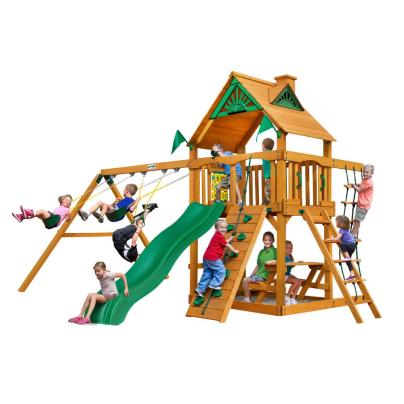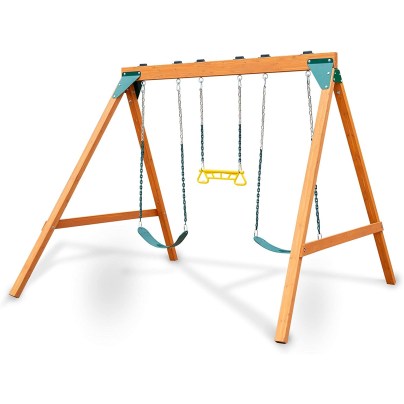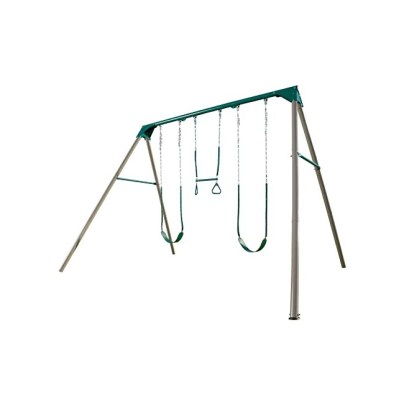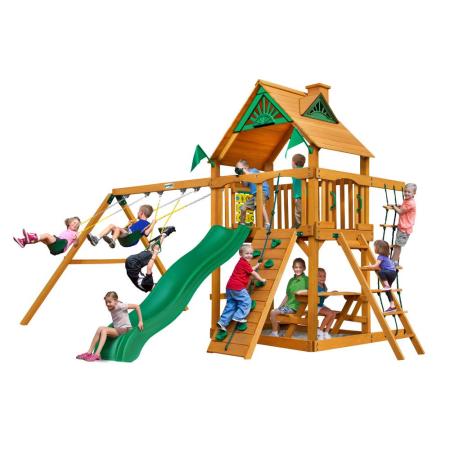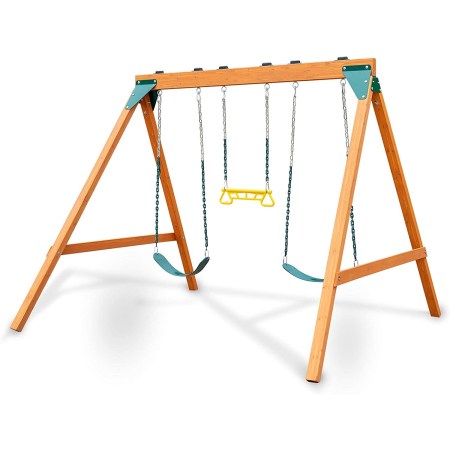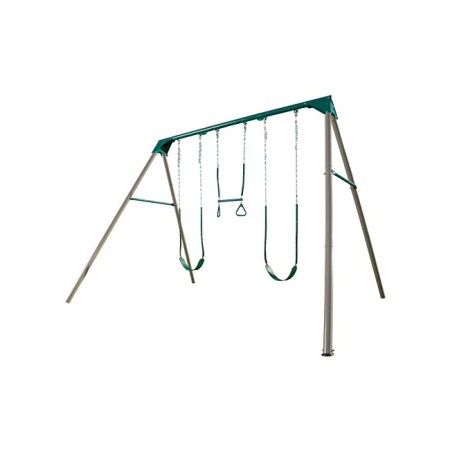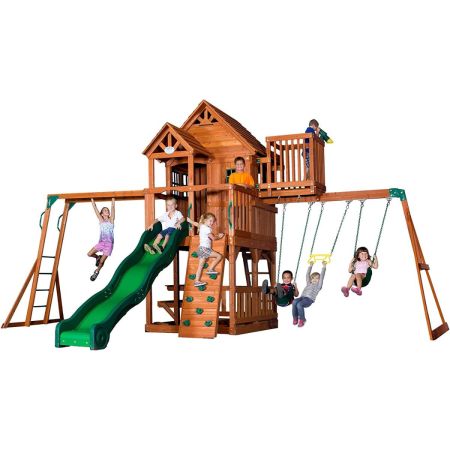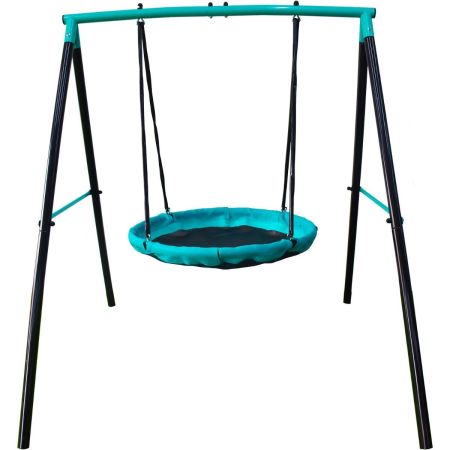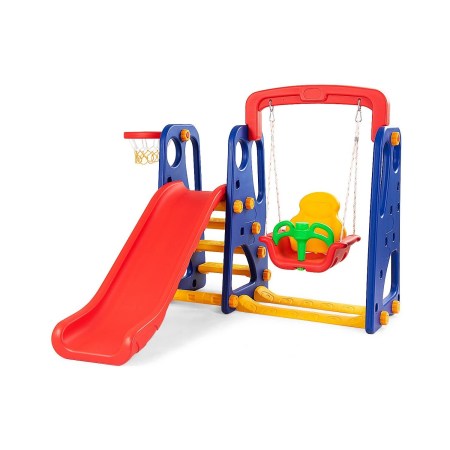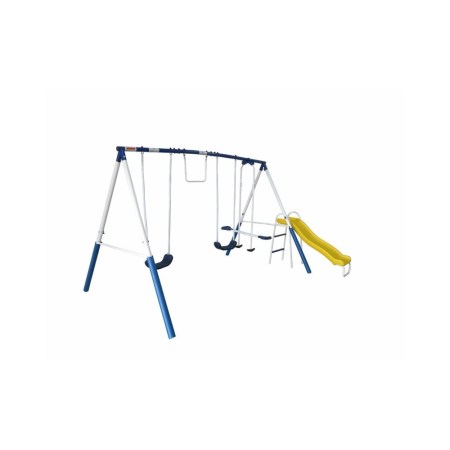We may earn revenue from the products available on this page and participate in affiliate programs. Learn More ›
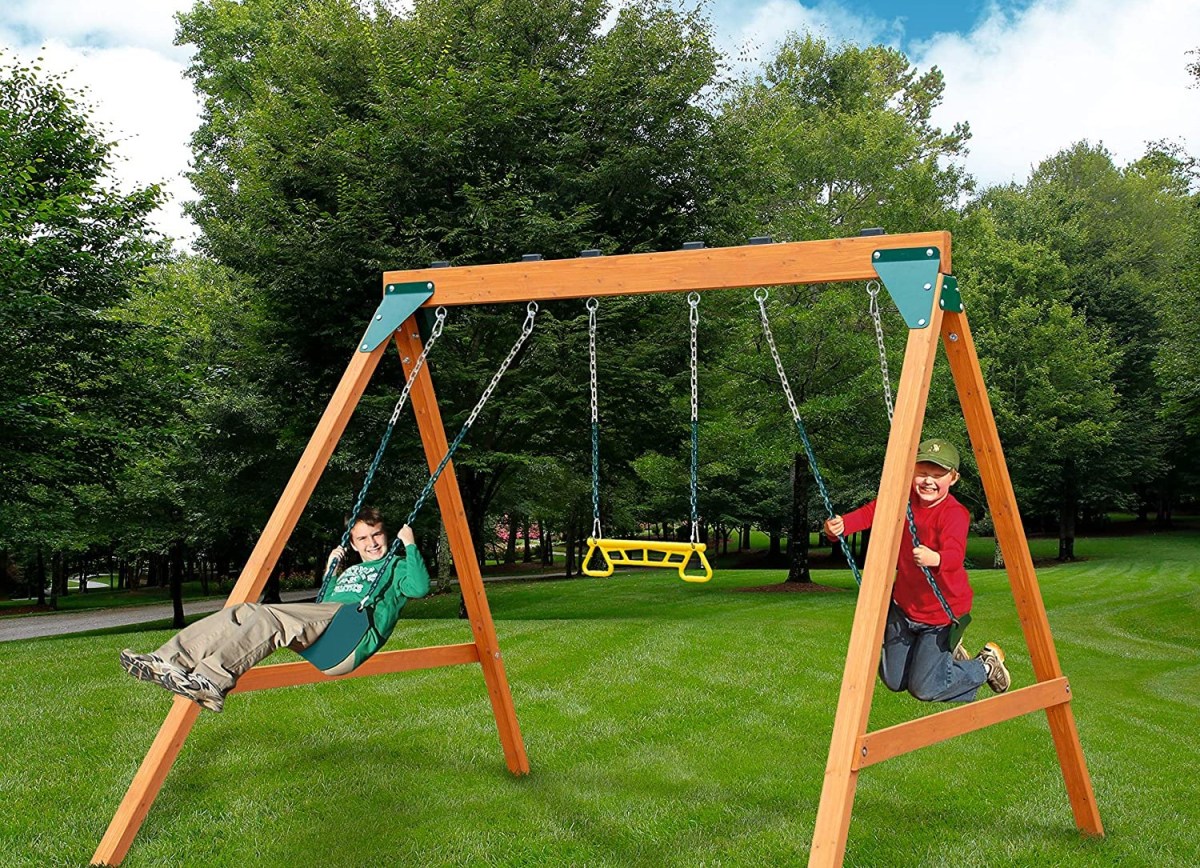
Swing sets provide an outlet for children to burn energy in the great outdoors. They are available in sizes large and small; can be constructed of wood, metal, or plastic; and feature a variety of swings, slides, and much more.
The best swing sets are made of high-quality materials that withstand both the elements and heavy play of rambunctious kids. They’re also convenient because homeowners don’t need a tree to hang a swing. This guide reviews some of the best swing sets available for the backyard and provides information about the features to consider when choosing the ideal swing set adventure for kids.
- BEST OVERALL: Gorilla Playsets Chateau Wooden Swing Set
- BEST BANG FOR THE BUCK: Swing-N-Slide PB 8360 Ranger Wooden Swing Set
- BEST METAL SWING SET: Lifetime Heavy Duty A-Frame Metal Swing Set
- BEST WOODEN SWING SET: Backyard Discovery Skyfort II
- BEST FOR SMALL YARDS: Jump Power UFO Swing Set
- BEST FOR BABIES: Costzon Toddler Climber and Swing Set
- BEST FOR TODDLERS: XDP Recreation Blue Ridge Play Swing Set
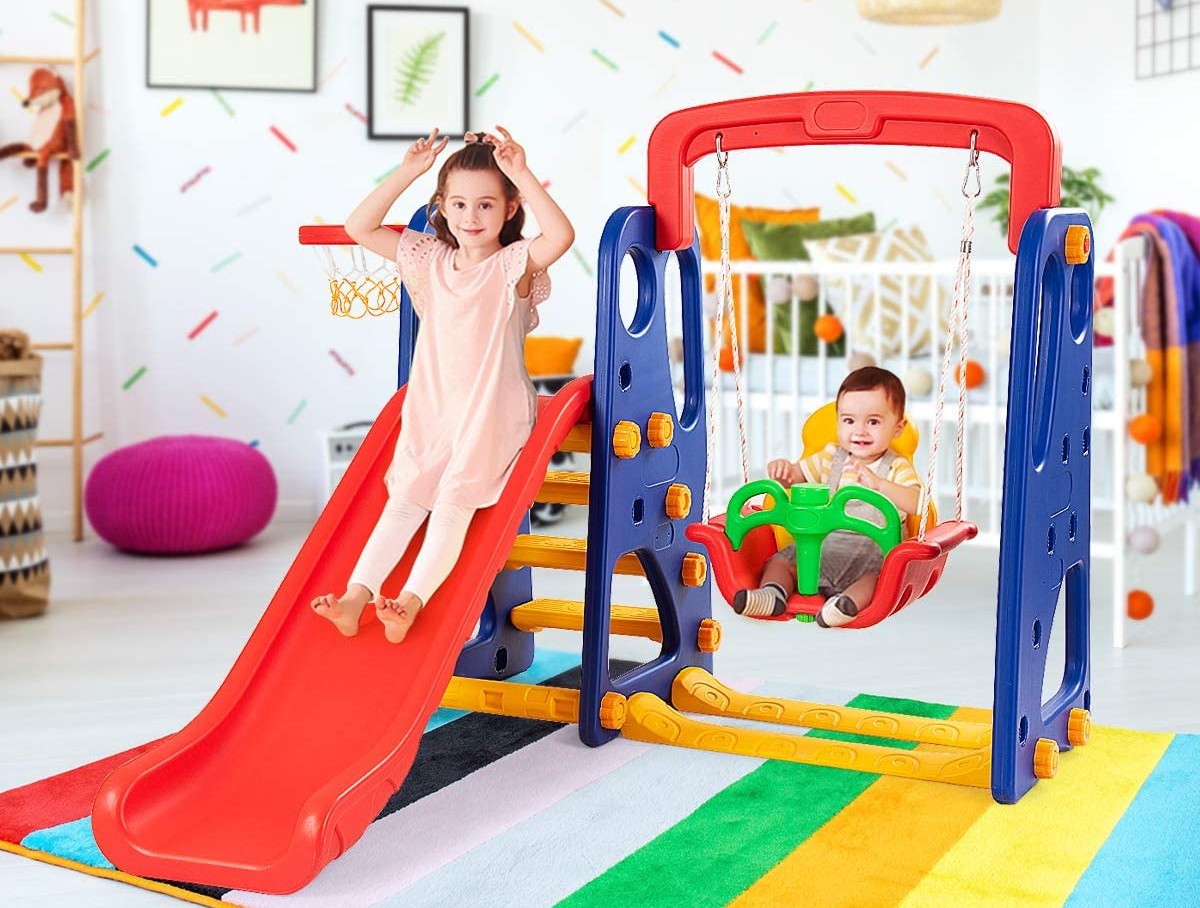
What to Consider When Choosing the Best Swing Set
Swing sets are made in a surprising range of configurations, featuring swings, slides, climbing walls, and bars of many shapes and sizes. The materials, age of a child or children, and installation and assembly options are only a few of the considerations to weigh when searching for the best swing set for a yard.
Material
Swing sets are typically constructed of either wood, metal, plastic, or a combination of these materials. Wooden swing sets provide a classic, natural look. Cedar and redwood are the most ideal for wooden swing sets because they naturally resist bugs and weather damage without chemical treatment. Some swing sets feature chemically treated wood to improve their pest and weather resistance. Keep in mind, however, that children will come into direct contact with chemicals every time they touch treated wood.
Wooden models hold up well, but they do require yearly restaining to maintain the quality. Even then, the wood may eventually rot and break down. Slivers are another concern with wooden swing sets. Children will run their hands over the wood frame during their play, so be prepared for occasional sliver removal.
Metal swing sets offer reliable durability. However, the quality of the metal and its protective coating can vary. Small to midsize swing sets that are more appropriate for younger kids are often made of steel or alloys with a protective coating. Galvanized steel and powder coats offer the best weather and rust resistance. The coating needs to protect the frame from nicks and scratches because anything that penetrates it can lead to the appearance of rust.
Heat is also a risk with metal swing sets. Metal frames grow hot in the sun and become a burn risk for children. Protective coatings help, but be sure to check the frame’s temperature by gently touching it before letting children play on the swing set. The same is true for metal slides, which can also become surprisingly hot, even on a cloudy day.
Wooden and metal swing sets often include plastic parts, particularly in the swing seats, while baby and toddler swing sets are typically made completely of plastic. These plastics should be hardy enough to withstand inclement weather, including prolonged sun exposure.
Take note of whether the plastic on a particular swing set is recommended for both indoor and outdoor use, and remember that—no matter how high the quality—plastic will eventually fade in the sun. However, there is no risk of slivers and rust and less risk of dangerous heat with plastic. Users should still check the temperature of plastic slides and swings to make sure they haven’t become too hot for use.
Age Range
Manufacturers include a recommended age range based on the swing set’s materials, size, and swing/slide design. It’s important to buy a swing set that’s appropriate for a child’s age; a swing set made for an 8-year-old child could pose a danger to a toddler.
Baby and toddler swing sets usually have a swing with a three-point or a five-point safety harness to hold the child securely while swinging. Their slides and ladders are also much smaller and may be textured to reduce the risk of falls and the chance of injury if there is a fall.
Size and Capacity
The size and layout of a yard determines the size of the backyard swing set it can accommodate. When making calculations, consider that 5 to 6 feet of clearance beyond the swing set’s footprint is necessary to allow plenty of room for children to swing. A smaller set may be required to provide safe clearance in a yard to avoid fences, pools, detached garages, sheds, driveways, and sidewalks.
Swing sets also have a maximum weight limit and capacity. The swings themselves usually have a maximum weight limit as well. If several children will be using the equipment, owners will need a model that’s designed to accommodate them all. Match the swing set size and capacity to the size, age, and weight of the children who’ll use it most often.
Features
All a swing set truly needs is a swing. However, many have two or more swings and several other options as well. Some features may include:
- Monkey bars
- A climbing wall
- One or more slides
- Trapeze bar
- Rings
- Ladders
- Saucer swing
- Tire swing
- Swing glider
- Benches or small picnic table
Some models also offer different kinds and sizes of swings such as those with a safety harness for infants and toddlers.
Location
A swing set should have plenty of clearance around it so children on the swings don’t hit any obstacles, people, or pets, and those not on the swing are still able to stay out of the swings’ range. Shady areas help prevent the frame, slides, and swings from becoming too hot at the height of summer.
Avoid areas near sheds, garages, fences, streets, and driveways to reduce the likelihood of accidents and injuries.
Safety
Safety always comes first. The swing set should be age appropriate, but it’s also important to keep an eye on the following components:
- Swings: Swings made of plastic and rubber are safer than metal or wood because they’re more stable, easier to sit on, and don’t grow as hot in the sun or have slivers. Swings should be at least 8 inches apart to reduce the chances of a mid-swing collision.
- Slides: Light-colored plastic slides stay cooler than metal slides. However, even light-colored plastic can become warm in hotter temperatures. Always check the slide’s temperature before a child goes down it.
- Protective Surfaces: Shock-absorbing surfaces under the swing set protect little bodies when they fall. Shredded rubber, sand, and wood chips are popular options. The protective surface should cover twice the height of the swing set in the front and back of the frame.
- Anchors: Swing sets that aren’t anchored to the ground can blow over in a heavy wind. Most wooden swing sets include metal stakes to hold them in place. Some metal swing sets don’t require anchors. Others don’t include anchors even though the manufacturer recommends them, so shoppers may need to purchase them separately to ensure safety.
Check the U.S. Consumer Product Safety Commission (CPSC) for additional suggestions and guidelines for purchasing the safest possible swing set.
Installation
All swing sets require some assembly and installation. Large swing sets with swings, slides, ladders, and a rock climbing wall may take several days to assemble. Some small, simple sets may offer tool-free assembly, but others may require a level, a drill, and other power tools, so make sure the necessary tools are on hand.
Try to match the swing set to the builder’s DIY skill level. The other option with large, complex swing sets is to hire a professional for assembly and installation.
Our Top Picks
Our top picks represent some of the best swing sets available, offering a range of sizes and designs to meet the various needs of different families and yards. They’re all made of high-quality materials, provide safe play, and boast features that will keep children entertained for hours.
The Chateau Wooden Swing Set from Gorilla Playsets is ideal for families with several children—or even just for a backyard where neighborhood kids congregate. The cedar naturally resists bugs, and a canopy covers the play deck for a shady play area.
The multitude of play options includes two standard swings, a trapeze swing, wave slide, climbing wall, rope ladder, tic-tac-toe station, and an under-deck play area with a bench. Children will find places to hide, ride, and burn off pent-up energy.
This swing set is quite sizable at 11 feet high by 19 feet wide by 14 feet deep and will fit well in larger backyards. Precut, pre-sanded, and predrilled, it’s ready for a painless assembly process. The maximum weight capacity stands at 800 pounds or about seven children ages 3 to 11, depending on weight.
Product Specs
- Dimensions: 11 feet high by 19 feet wide by 14 feet deep
- Weight capacity: 800 pounds
- Recommended ages: 3 to 11 years
Pros
- Multiple swings
- Climbing and imagination features
- Shaded play areas
Cons
- Expensive
Get the Gorilla Playsets swing set at The Home Depot or Overstock.
The sturdy construction and swing options of this Swing-N-Slide set encourage young families and those with several children to jump into outdoor play. A gorgeous cedar frame resists the effects of inclement weather and insect infestation. Pinch-free chains coated in plastisol keep little fingers safe.
One of the most practical features of this swing set is the design of the swing attachments, which allows users to alternate between a toddler swing (which must be purchased separately) and other swing designs as children grow. With a footprint of 6.8 feet high by 8.5 feet wide by 7.5 feet deep, it fits in small-to-midsize yards without taking up too much outdoor space.
Each plastic swing holds up to 115 pounds, and the entire swing set holds a maximum of three children.
Product Specs
- Dimensions: 6.8 feet high by 8.5 feet wide by 7.5 feet deep
- Weight capacity: 115 pounds
- Recommended ages: 3 months to 10 years old
Pros
- Versatile swing attachment design
- Pinch-free chains
- Resists insect infestation
Cons
- May be too small for older kids
Get the Swing-N-Slide swing set on Amazon.
A sturdy frame design that’s completely freestanding allows parents to install this metal swing set from Lifetime without anchoring it. However, owners can always anchor it for extra stability. This heavy-duty swing set is among our top picks for the durability and quality of the low-alloy powder-coated steel frame. It resists inclement weather and sun damage and poses no risk of bug infestation.
The swing seats are made of UV-protected polyethylene plastic that resists fading and remains cool in prolonged sunlight. The swing chains have a soft rubber grip to prevent pinched fingers. This swing set is suitable for children ages 3 to 12 and has dimensions of 9.3 feet high by 13.5 feet wide by 10.5 feet deep, making it appropriate for midsize to large backyards.
Product Specs
- Dimensions: 9.3 feet high by 13.5 feet wide by 10.5 feet deep
- Weight capacity: 405 pounds
- Recommended ages: 3 to 12 years
Pros
- Freestanding design
- High maximum weight limit for the size of the swing set
- Soft grips on swing chains
Cons
- Expensive
Get the Lifetime swing set at Tractor Supply Co.
This wooden swing set has a little (or a lot) of everything. One wing has two swings and a trapeze bar, while the other provides a climbing ladder. In the center, a slide and climbing wall lead up to the raised clubhouse. Kids have a covered place to play as well as a lookout area for a view. Underneath, they can stay cool while sipping lemonade at the picnic table.
The swing chains have a plastic cover to protect little fingers, and the ladder and climbing wall have handholds for added safety. This swing set has a large footprint of 22 feet long by 16.75 feet wide by 12.45 feet high, so homeowners will need a good amount of space for clearance. This swing set has a water-based stain and has not been chemically treated, so it may require additional treatment or maintenance to prevent rot or bug infestation.
Product Specs
- Dimensions: 22 feet long by 16.75 feet wide by 12.45 feet high
- Weight capacity: 600 pounds
- Recommended ages: 3 to 10 years
Pros
- Multiple play features
- Covered play areas, including a covered picnic table
- Space for lots of children
Cons
- May require additional maintenance because it hasn’t been chemically treated
- Large footprint
Get the Backyard Discovery swing set on Amazon.
The UFO swing from Jump Power features a powder-coated steel frame that offers excellent durability and stability, despite its relatively small size. The frame resists the elements and poses no risk of bug infestation. The dimensions measure 6 feet high by 5.5 feet wide by 5.9 feet deep for a compact swing set that fits in small yards.
This saucer swing holds two children of up to 100 pounds each. A protective coating covers the swing’s chains to protect small fingers. Designed for children ages 3 to 8, it’s an ideal choice for young families. Anchors need to be purchased separately.
Product Specs
- Dimensions: 6 feet high by 5.5 feet wide by 5.9 feet deep
- Weight capacity: 200 pounds
- Recommended ages: 3 to 8 years
Pros
- Small footprint
- Holds 2 children
- Stable design even when fully loaded
Cons
- Does not come with anchors
Get the Jump Power swing set on Amazon.
The Costzon swing set offers babies their first taste of swinging. Once babies can sit up on their own, there is a safety bar with handles to keep them safe in the swing. The slide accommodates toddlers as they start taking their first steps and learning to climb. A textured surface on the ladder helps with stability. Plus, there’s a basketball hoop for the budding athlete to work on hand-eye coordination.
For an outdoor model, the swing set is fairly small at 4 feet high by 5.5 feet wide by 5 feet deep. However, this swing set is appropriate for indoor or outdoor use. The heavy-duty plastic can withstand sun exposure, but it’s also ideal for indoor use as well as being colorful and eye-catching. The swing holds up to 66 pounds, while the slide can hold up to 110 pounds.
Product Specs
- Dimensions: 4 feet high by 5.5 feet wide by 5 feet deep
- Weight capacity: 110 pounds (slide), 66 pounds (swing)
- Recommended ages: 2 to 8 years
Pros
- Small footprint
- Bright colors
- Indoor or outdoor use
Cons
- Swing may be too low for older kids
Get the Costzon swing set on Amazon.
The Blue Ridge metal swing set from XDP Recreation acts as a transition between a baby swing set and a larger playset. It offers two plastic-seated swings, a trapeze bar, a slide, and a two-seat built-in glider. Toddlers can enjoy swinging without a safety harness but in a smaller and more secure setting than sets built for older kids.
Designed for children ages 3 to 8, this set’s durable metal frame with padded legs offers extra protection for little ones who aren’t yet as aware of their surroundings as older children. The swings have metal bars rather than chains to protect little fingers from pinches.
With dimensions of approximately 6 feet high by 11 feet wide by 8 feet deep, it won’t completely overtake a yard. Overall, this set offers many of the joys of larger swing sets but with a few extra safety measures to keep toddlers safe. It’s also sturdy, even when it’s loaded with several kids. However, there are reports of the set arriving missing a few pieces of hardware.
Product Specs
- Dimensions: 6 feet high by 11 feet wide by 8 feet deep
- Weight capacity: 600 pounds
- Recommended ages: 3 to 8 years
Pros
- Padded frame legs
- Easy setup
- Sturdy even when fully loaded
Cons
- May arrive with missing pieces
Get the XDP Recreation swing set on Amazon or at Target.
Our Verdict
We found the Gorilla Playsets swing set to be among the best swing sets available. It’s the kind of swing set that will keep kids outside all day, playing with siblings and friends. It offers two covered play areas, a slide, swings, and climbing features. However, if the buyer’s budget is a little smaller, the Swing-N-Slide swing set has a solid build and swing designs that let kids enjoy the backyard for hours on end. It balances quality and price for those who don’t have thousands to spend.
How We Chose the Best Swing Sets
When it comes to kids’ equipment or gear of any kind, safety is always our first concern. We looked for swing sets with designs that went beyond basic safety to include chain covers, handrails, and screw covers. Our other major considerations included durability, stability, size, weight limit, and play features.
Durable materials, such as woods that naturally withstand insects or chemically treated woods, were always at the forefront of our considerations. Powder-coated steel that doesn’t rust easily is another mark of durability. As far as stability, we looked for solid, stable designs that were either made to be anchored or could remain stable without the help of anchors. The swing set’s maximum weight limit also factored into stability. Higher weight limits let either more kids or bigger kids play without fear of breaking the swing set or getting injured.
Because every yard isn’t the same size, we considered swing sets in different sizes and configurations to fit a variety of outdoor (and some indoor) spaces. Finally, we looked at play features. A swing set needs excellent swings that include safe, comfortable seats and strong chains or ropes. Although we liked additional play features and included several models with multiple play features, we always considered the swing portion of the set first.
FAQs
It’s easy to get overwhelmed when choosing a swing set out of the numerous options available. There are ways to narrow choices, including considering the size and layout of a yard, the location in which the swing set will be placed, and the features most desired by homeowners and children. Check out some of the most frequently asked questions about how to select the best swing set for an owner’s needs.
Q. What should buyers look for when shopping for a swing set?
The first consideration should be high-quality materials. Cedar, redwood, rust-resistant coated metals, and heavy-duty plastics that withstand sun damage are safer and more durable. Make sure the swing set is age appropriate with an in-between swing distance of at least 8 inches. The swing set should fit in a yard with 5 to 6 feet of clearance around the set’s footprint.
Q. How tall should a swing set be?
Height doesn’t become an issue unless the swing set is considerably taller than it is wide, which isn’t a problem with models that are safety approved. However, keep an eye on placement. Don’t situate a swing set near poles or wires that could snag the swings.
Some swing sets feature a roof that should also avoid wires or poles. Children are adept climbers and could end up in unexpected places.
Q.How is a swing set leveled?
It’s essential to level the ground underneath the swing set. A level base—combined with anchors—prevents the swing set from tipping over. Even if the ground is already level, installers will need to dig out the area to make room for shock-absorbing ground material. Use stakes, a string, and a carpenter’s level to make sure the entire play area is level.
Q.How is a metal swing set anchored?
The most common method for anchoring a metal swing set is concrete. It requires digging holes for each leg of the frame, filling them in with concrete, and then inserting the frames.
Q. How can a wooden swing set be moved?
Before disassembling, check the swing set for rust spots and wood rot. These are areas where the owner may need to take extra caution and mark for future repairs. Remove the screws from all major components: frame legs, swings, slides, and other features like a climbing wall. Disassemble the swing set into pieces small enough to fit into a vehicle. Make sure to label all components to aid in easy reassembly.
